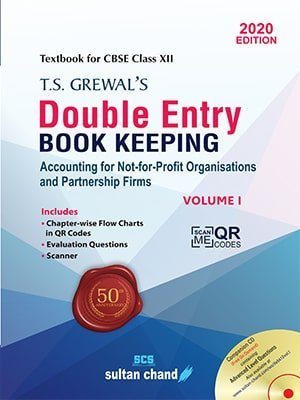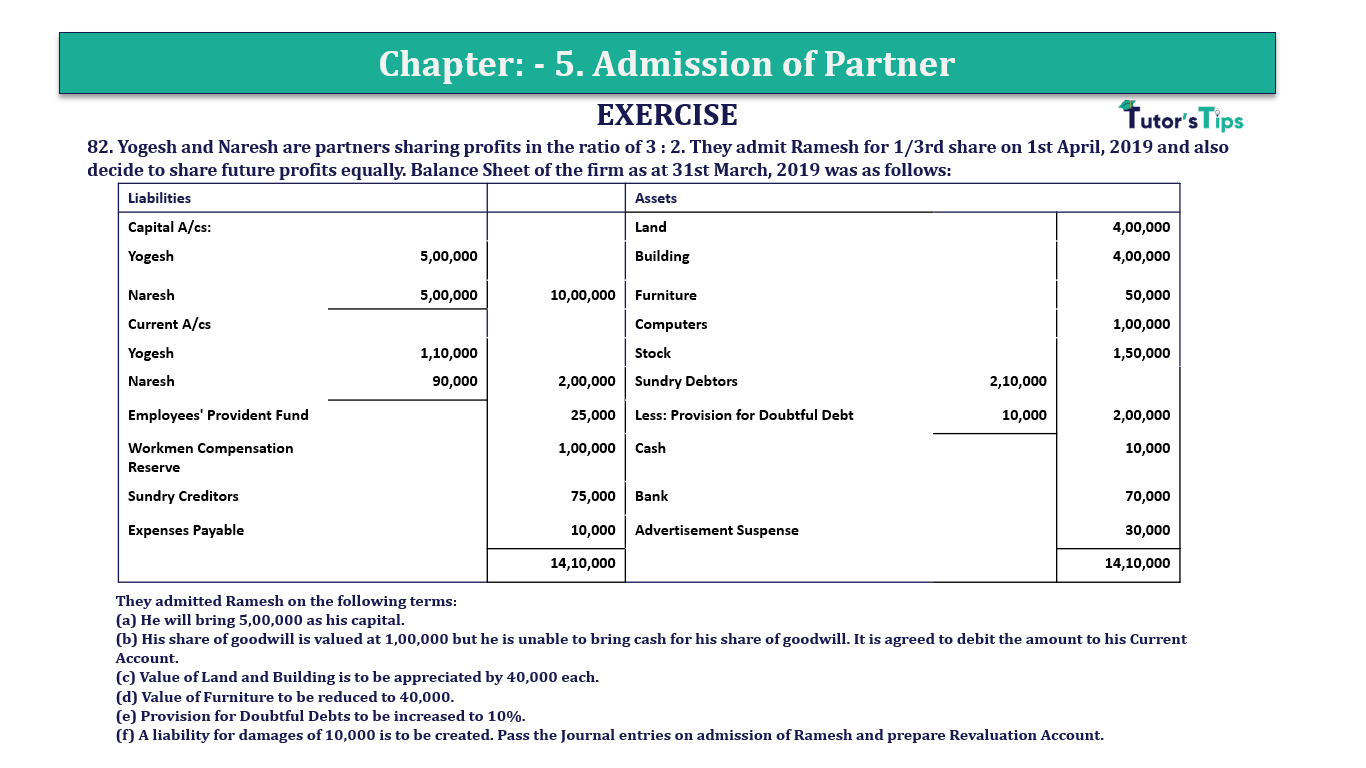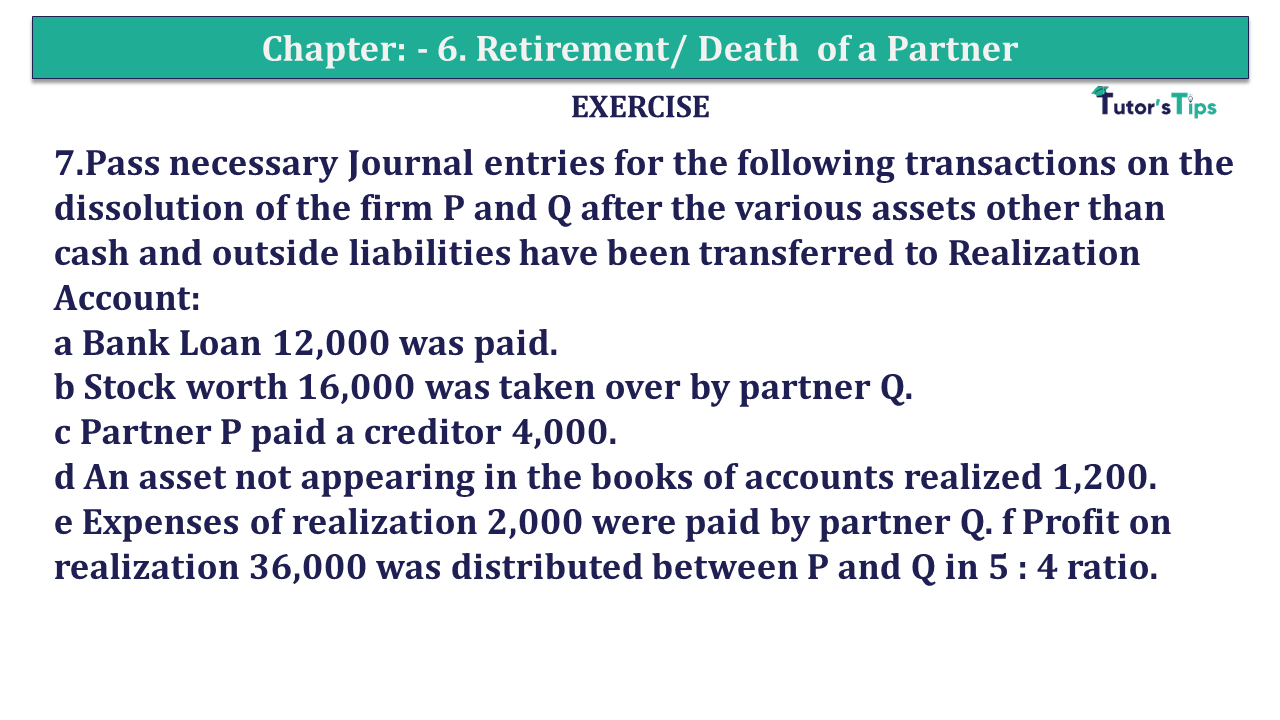Question 82 Chapter 5 of +2-A
82. Yogesh and Naresh are partners sharing profits in the ratio of 3 : 2. They admit Ramesh for 1/3rd share on 1st April, 2019 and also decide to share future profits equally. Balance Sheet of the firm as at 31st March, 2019 was as follows:
| Liabilities | Assets | ||||
| Capital A/cs: | Land | 4,00,000 | |||
| Yogesh | 5,00,000 | Building | 4,00,000 | ||
| Naresh | 5,00,000 | 10,00,000 | Furniture | 50,000 | |
| Current A/cs | Computers | 1,00,000 | |||
| Yogesh | 1,10,000 | Stock | 1,50,000 | ||
| Naresh | 90,000 | 2,00,000 | Sundry Debtors | 2,10,000 | |
| Employees’ Provident Fund | 25,000 | Less: Provision for Doubtful Debt | 10,000 | 2,00,000 | |
| Workmen Compensation Reserve | 1,00,000 | Cash | 10,000 | ||
| Sundry Creditors | 75,000 | Bank | 70,000 | ||
| Expenses Payable | 10,000 | Advertisement Suspense | 30,000 | ||
| 14,10,000 | 14,10,000 |
They admitted Ramesh on the following terms:
(a) He will bring 5,00,000 as his capital.
(b) His share of goodwill is valued at 1,00,000 but he is unable to bring cash for his share of goodwill. It is agreed to debit the amount to his Current Account.
(c) Value of Land and Building is to be appreciated by 40,000 each.
(d) Value of Furniture to be reduced to 40,000.
(e) Provision for Doubtful Debts to be increased to 10%.
(f) A liability for damages of 10,000 is to be created. Pass the Journal entries on admission of Ramesh and prepare Revaluation Account.
The solution of Question 82 Chapter 5 of +2-A: –
| Date | Particulars |
L.F. | Debit | Credit | |
| Cash A/c | Dr | 5,00,000 | |||
| To Abhay’s Capital A/c | 5,00,000 | ||||
| (Being amount due to Abhay transferred to his Capital A/c) | |||||
| Cash A/c | Dr | 1,00,000 | |||
| To Yogesh’s Current A/c (1,00,000 × 4/5) | 80,000 | ||||
| To Naresh’s Current A/c (1,00,000 × 1/5) | 20,000 | ||||
| (Being Capital and goodwill paid by the new partner | |||||
| Revaluation A/c | Dr | 31,000 | |||
| To Provision for Doubtful Debts A/c | 11,000 | ||||
| To Liability for damages A/c | 10,000 | ||||
| To Furniture A/c | 10,000 | ||||
| (Being assets revalued and liabilities reassessed) | |||||
| Land A/c | Dr | 40,000 | |||
| Building A/c | Dr | 40,000 | |||
| To Revaluation A/c | 80,000 | ||||
| (Being appreciation in land and building provided for) | |||||
| Revaluation A/c (WN2) | Dr | 49,000 | |||
| To Yogesh’s Current A/c | 29,400 | ||||
| To Naresh’s Current A/c | 19,600 | ||||
| (Being revaluation profit transferred to partner’s current A/c) | |||||
| Workmen Compensation Reserve A/c | Dr | 1,00,000 | |||
| To Yogesh’s Current A/c | 60,000 | ||||
| To Naresh’s Current A/c | 40,000 | ||||
| (Being workmen compensation reserve distributed) | |||||
| Yogesh’s Current A/c | Dr | 18,000 | |||
| Naresh’s Current A/c | Dr | 12,000 | |||
| To Advertisement Suspense A/c | 30,000 | ||||
| (Being accumulated loss written off) | |||||
Working Note:-
Calculation of new profit-sharing ratio
Old Ratio of Yogesh and Gopal = 3 : 2
New Ratio of Yogesh and Gopal = 1 : 1
| Yogesh’s New Ratio | = | 3 | – | 1 |
| 5 | 3 |
| = | 9- 5 | |
| 15 |
| = | 4 | |
| 15 |
| Gopal’s New Ratio | = | 2 | – | 1 |
| 5 | 3 |
| = | 6- 5 | |
| 15 |
| = | 1 | |
| 15 |
Calculation of Revaluation Profit/Loss:
| Debit side total | = | (11,000 + 10,000 + 10,000) |
| = | 31,000 | |
| Credit side total | = | 80,000 |
| Gain on Revaluation | = | (80,000 – 31,000) |
| = | 49,000 |
T.S. Grewal’s Double Entry Book Keeping +2 (Vol. I: Accounting for Not-for-Profit Organizations and Partnership Firms)
- Chapter No. 1 – Financial Statement of Not-For-Profit Organisations
- Chapter No. 2 – Accounting for Partnership Firms – Fundamentals
- Chapter No. 3 – Goodwill: Nature and Valuation
- Chapter No. 4 – Change in Profit-Sharing Ratio Among the Existing Partners
- Chapter No. 5 – Admission of a Partner
- Chapter No. 6 – Retirement/Death of a Partner
- Chapter No. 7 – Dissolution of a Partnership Firm
T.S. Grewal’s Double Entry Book Keeping (Vol. II: Accounting for Companies)
- Chapter No. 8 – Company Accounts – Accounting for Share Capital
- Chapter No. 9 – Company Accounts – Issue of Debentures
- Chapter No. 10 – Redemption of Debentures
T.S. Grewal’s Double Entry Book Keeping (Vol. II: Accounting for Companies)
- Chapter No. 1 – Financial Statements of a Company
- Chapter No. 2 – Financial Statement Analysis
- Chapter No. 3 – Tools of Financial Statement Analysis – Comparative Statements and Common- Size Statements
- Chapter No. 4 – Accounting Ratios
- Chapter No. 5 – Cash Flow Statement
Advertisement-X
Check out T.S. Grewal +2 Book 2020@ Official Website of Sultan Chand Publication








Leave a Reply